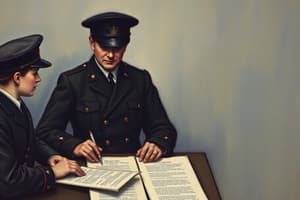Podcast
Questions and Answers
What was the Schlieffen Plan?
What was the Schlieffen Plan?
- A plan to defeat France by invading from the east
- A plan to defeat France by seeking assistance from Great Britain
- A plan to defeat France by heavily fortifying the German border
- A plan to defeat France by invading through neutral Belgium with an overwhelming force (correct)
What action led Great Britain to declare war on Germany?
What action led Great Britain to declare war on Germany?
- Germany's violation of Belgium's neutrality (correct)
- Germany's refusal to join the Allied Powers
- Germany's attack on Russia
- Germany's refusal to negotiate a peace treaty
What made the conflict a true 'world war'?
What made the conflict a true 'world war'?
- Japan's declaration of war on Germany
- The Ottoman Empire's entry into the war
- Britain's declaration of war on Germany (correct)
- Germany's invasion of France
Which countries were known as the Central Powers?
Which countries were known as the Central Powers?
Which country captured Jerusalem during World War I?
Which country captured Jerusalem during World War I?
What did Britain and Germany do on the high seas during the war?
What did Britain and Germany do on the high seas during the war?
What was the main reason for the German forces to transfer some troops back to Germany?
What was the main reason for the German forces to transfer some troops back to Germany?
Which battlefront was dissolved due to Russia's withdrawal from the war in December 1917?
Which battlefront was dissolved due to Russia's withdrawal from the war in December 1917?
Which new weapon contributed to the shocking destruction of World War I by firing 600 bullets per minute?
Which new weapon contributed to the shocking destruction of World War I by firing 600 bullets per minute?
What type of war was World War I characterized as due to the mobilization of all resources, both military and civilian, to win the war?
What type of war was World War I characterized as due to the mobilization of all resources, both military and civilian, to win the war?
Flashcards are hidden until you start studying
Study Notes
Schlieffen Plan
- A military strategy devised by Germany aimed at quickly defeating France by invading through Belgium, then turning to fight Russia.
Great Britain's Declaration of War
- Germany's invasion of Belgium in August 1914 prompted Great Britain to declare war, as it violated Belgian neutrality.
Global Nature of the Conflict
- World War I became a true 'world war' due to the involvement of numerous countries beyond Europe, including colonies and dominions.
Central Powers
- The main countries aligned as the Central Powers included Germany, Austria-Hungary, the Ottoman Empire, and Bulgaria.
Capture of Jerusalem
- During World War I, British forces captured Jerusalem in December 1917, marking a significant event in the Middle Eastern theater of the war.
Naval Operations
- Britain and Germany engaged in extensive naval warfare, including battleships, submarines (U-boats), and blockades in the North Sea and the Atlantic.
Troop Transfer Reasoning
- The primary reason for transferring German troops back to Germany was to address threats on the home front and reinforce defenses against growing military pressures.
Dissolved Battlefront
- The Eastern Front was dissolved following Russia's withdrawal from the war due to the Treaty of Brest-Litovsk in December 1917.
New Weaponry
- The introduction of the machine gun, capable of firing 600 bullets per minute, significantly increased the lethality and destruction on the battlefield.
Characterization of World War I
- World War I was characterized as a total war, where all resources from military to civilian sectors were mobilized to support the war effort and achieve victory.
Studying That Suits You
Use AI to generate personalized quizzes and flashcards to suit your learning preferences.




